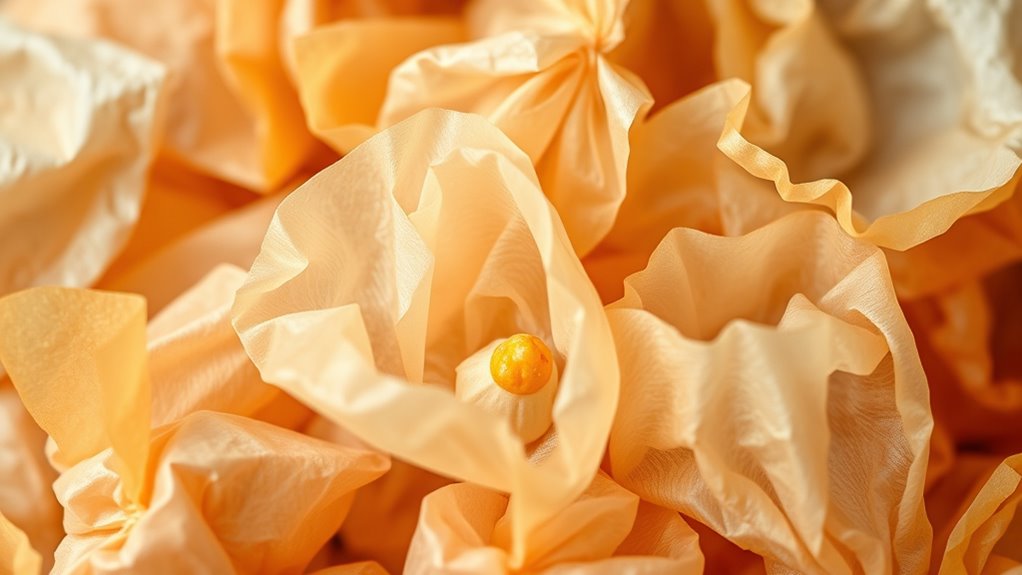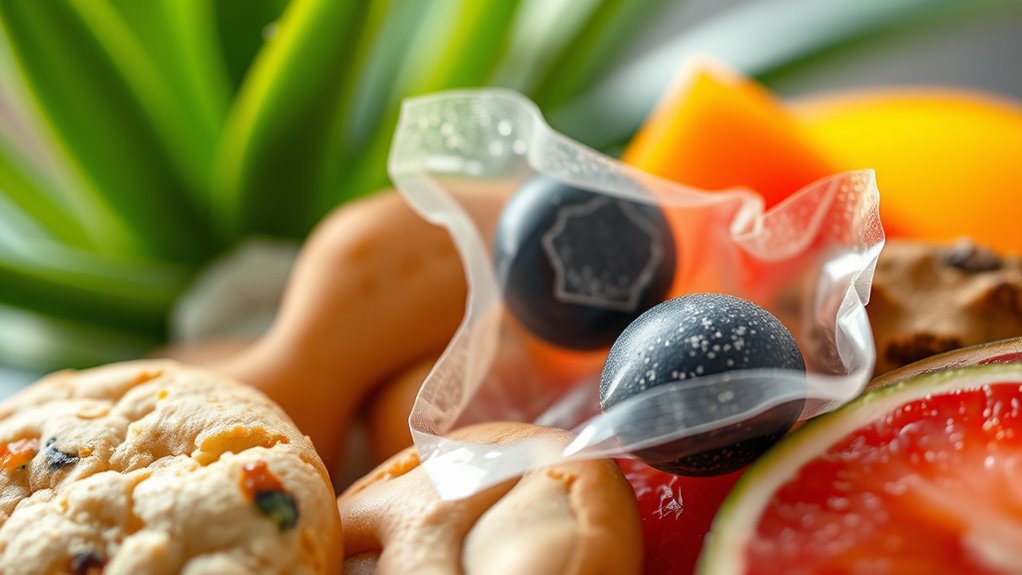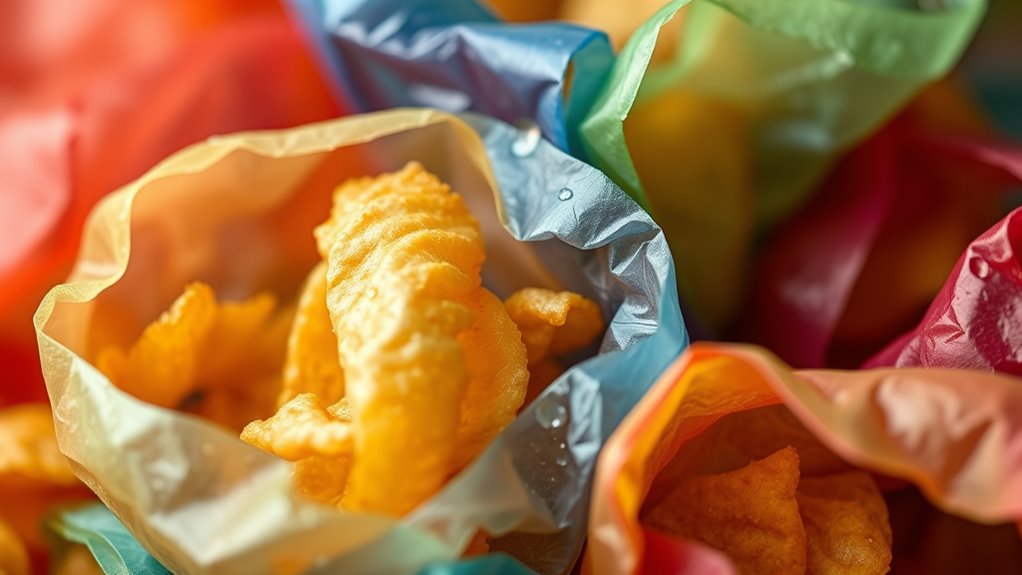Edible packaging is revolutionizing snacks by turning wrappers into consumable, eco-friendly treats that reduce waste and improve your experience. Using natural ingredients like seaweed, rice, or plants, these wrappers can be flavored and customized, making snack time more enjoyable. Advances in technology and sustainability efforts are making edible wrappers more practical and appealing. If you want to discover how this innovative shift can change your snacks, keep exploring these exciting developments.
Key Takeaways
- Edible packaging transforms wrappers into consumable snacks by integrating flavors and textures into biodegradable, edible materials.
- Innovations enable wrappers to be flavored, textured, and customized, enhancing the snacking experience while reducing waste.
- Natural ingredients like seaweed, rice, or plant-based polymers serve as both packaging and edible components.
- Advanced manufacturing and AI technologies facilitate the development of tasty, durable, and eco-friendly edible wrappers.
- Edible packaging promotes sustainability by turning waste into a part of the snack, aligning with consumer preferences and environmental goals.
The Evolution of Food Packaging: From Plastic to Edible Solutions

Food packaging has come a long way, evolving from traditional plastic materials that often harm the environment. Today, biodegradable plastics are at the forefront of sustainable solutions, breaking down naturally and reducing waste. Packaging regulations have also shifted to encourage eco-friendly practices, pushing companies to adopt materials that are less harmful. These regulations aim to minimize plastic pollution and promote innovation in packaging design. As a result, many brands are exploring biodegradable options that meet safety standards while being environmentally responsible. This shift not only helps protect ecosystems but also appeals to increasingly eco-conscious consumers. The move from conventional plastics to biodegradable alternatives marks a significant step toward more sustainable food packaging, setting the stage for further innovations like edible wrappers. Additionally, wall organization systems can inspire creative ways to display and promote these eco-friendly packaging solutions.
Materials and Innovations Behind Edible Wrappers

You’ll find that natural, biodegradable ingredients form the core of edible wrappers, making them eco-friendly and safe to consume. Innovative manufacturing techniques enable these materials to be produced efficiently and at scale. Together, these advances are transforming how we think about sustainable packaging solutions, offering environmentally conscious options for the future.
Natural, Biodegradable Ingredients
Natural, biodegradable ingredients form the foundation of innovative edible wrappers, offering a sustainable alternative to traditional packaging. These ingredients come from sources like seaweed, rice, and plants, making them eco-friendly and safe for consumption. They also allow for flavor customization, enhancing consumer acceptance by tailoring taste profiles to preferences. By using natural components, manufacturers can create wrappers that degrade easily without harming the environment. Incorporating tea brewing techniques can influence flavor infusion and texture in edible packaging. These ingredients demonstrate how natural, biodegradable options make edible packaging both functional and appealing to eco-conscious consumers.
Cutting-Edge Manufacturing Techniques
Innovations in manufacturing techniques are driving the development of more durable, functional edible wrappers by utilizing advanced materials and processing methods. You’ll find that edible coatings now incorporate innovative ingredients that improve barrier properties, ensuring freshness and protection. These coatings often include natural polymers, such as starches or proteins, enhanced with flavor enhancements to boost taste and consumer appeal. Modern techniques like spray drying, extrusion, and casting allow precise control over thickness, texture, and flavor infusion. By applying these methods, manufacturers can produce wrappers that are not only strong and flexible but also customizable in flavor and appearance. This synergy of cutting-edge materials and processing methods results in edible wrappers that meet both functional and sensory expectations, making food packaging more sustainable and enjoyable. Additionally, drivetrain components can influence the overall durability and performance of the packaging, ensuring the wrappers maintain integrity during handling and storage.
Environmental Benefits of Edible Packaging

Edible packaging offers significant environmental advantages by reducing waste and decreasing reliance on traditional plastics. By replacing non-biodegradable waste with edible materials, you help lower the ecological impact of packaging. This shift means less trash in landfills and oceans, which benefits wildlife and ecosystems. Edible packaging decomposes naturally, minimizing the accumulation of biodegradable waste. Additionally, it reduces the need for fossil fuels used in plastic production. These eco-friendly benefits make edible packaging a sustainable choice for the future. Sustainable practices can be further supported by integrating edible packaging into broader waste reduction efforts.
Popular Edible Packaging Products and Their Uses

Many popular edible packaging products are designed to serve specific functions across various industries, making them versatile alternatives to traditional materials. For example, edible films and wrappers are used in snacks, candies, and fast food, often incorporating unique flavor combinations that enhance taste. Cultural adaptations also influence product varieties, such as seaweed-based wrappers in Asian cuisine or rice paper in Vietnamese spring rolls. These products not only protect and preserve food but also add an extra layer of flavor and experience. Additionally, sustainable packaging is becoming increasingly important as consumers seek eco-friendly options that reduce waste and environmental impact.
Challenges and Limitations of Edible Packaging

You might wonder how long edible packaging can keep food fresh, as preservation and shelf life remain concerns. Additionally, producing these materials often involves higher costs and complex processes that challenge scalability. These limitations make it difficult to adopt edible packaging widely across different industries. Moreover, AI-driven solutions are increasingly being explored to improve the efficiency and effectiveness of edible packaging materials.
Preservation and Shelf Life
Maintaining the freshness and safety of products wrapped in edible packaging poses significant challenges due to their delicate nature. Edible wrappers often have a limited shelf life, risking spoilage or loss of texture. Preservation becomes tricky because moisture, air, and bacteria can quickly compromise the packaging and the product inside. This can be further complicated by the contrast ratio, which influences how well the packaging maintains its integrity under different lighting conditions. This affects not only taste enhancement but also consumer acceptance, as outdated or spoiled packaging can deter buyers.
Some key challenges include:
- Short shelf life compared to traditional packaging
- Sensitivity to humidity and temperature fluctuations
- Potential for microbial growth
- Difficulty in balancing durability with edibility
Production and Cost Challenges
Producing edible packaging often involves complex, costly processes that can hinder large-scale adoption. Developing cost-effective methods and scaling production remain major hurdles. High-quality ingredients and specialized equipment drive up expenses, making it difficult to reduce costs. To address this, companies explore efficient manufacturing techniques, but these aren’t always proven at scale. Additionally, Honda Tuning principles such as optimizing manufacturing processes can be adapted to improve production efficiency in edible packaging.
The Future of Sustainable Snacking

As consumers increasingly prioritize sustainability, the future of snacking is shifting toward edible packaging that combines convenience with eco-friendliness. You’ll see more products offering snack customization, allowing you to choose flavors and formats that suit your preferences while reducing waste. As acceptance grows, manufacturers will innovate with tastier, more appealing edible wrappers that blend seamlessly with snacks. This trend encourages a circular approach to packaging, where waste becomes part of the product. Additionally, advances in biodegradable ingredients will make these snacks safer for the environment. Expect brands to focus on transparency and educating consumers about the benefits, boosting overall consumer acceptance. The influence of AI in food design can also accelerate innovation in creating sustainable ingredients, making edible packaging more environmentally friendly and appealing. Ultimately, edible packaging will transform the way you snack—more sustainable, personalized, and enjoyable.
Frequently Asked Questions
How Long Do Edible Wrappers Typically Last Before Degrading?
You might wonder how long edible wrappers last before degrading. Typically, their biodegradation process takes a few days to weeks, depending on environmental conditions like moisture and temperature. These wrappers offer significant environmental benefits by breaking down quickly and reducing waste. When you choose edible packaging, you’re supporting eco-friendly solutions that minimize pollution and help preserve natural resources, making it a smart choice for sustainable living.
Are Edible Packaging Options Safe for People With Allergies?
Imagine biting into a snack wrapped in edible packaging, but you’re worried about allergies. You should check if the packaging undergoes thorough allergy testing and offers ingredient transparency. This way, you’ll know exactly what’s in it and avoid any allergic reactions. Always read labels carefully, especially if you have sensitivities, and choose products from trusted brands that prioritize safety for allergy sufferers.
What Flavors Are Available for Edible Packaging?
You’re curious about the flavors available for edible packaging. Thanks to flavor innovations, manufacturers now offer a variety of options like sweet, savory, and even spicy tastes, enhancing your sensory experiences. These flavors are designed to complement the food they package, making the eating experience more enjoyable. As technology advances, expect even more creative and diverse flavor options, allowing you to customize your edible packaging to suit your preferences.
Can Edible Wrappers Be Reused or Recycled?
You might wonder if edible wrappers can be reused or recycled. While they aren’t typically recyclable like traditional packaging, they offer biodegradability benefits that reduce environmental impact. Since these wrappers are designed to be edible, reuse isn’t practical, but disposal is eco-friendly, helping lower waste. Choosing edible packaging supports sustainability and minimizes pollution, making it a smart, eco-conscious choice for reducing your carbon footprint.
How Do Edible Wrappers Impact Food Shelf Life?
You might wonder how edible wrappers impact food shelf life. These wrappers undergo a degradation process that can either extend or shorten freshness, depending on their composition. Their environmental benefits include reducing waste and pollution. However, if not properly formulated, they may speed up spoilage or compromise food quality. Balancing durability with biodegradability is key to ensuring edible wrappers support both food preservation and environmental sustainability.
Conclusion
As you explore edible packaging, you’ll see it’s truly a game-changer. It transforms waste into a tasty treat, proving that necessity is the mother of invention. While challenges remain, embracing these innovations can help you reduce your environmental footprint and enjoy snacks that are both smart and sustainable. It’s clear that with a little ingenuity, we can turn the tide and make a real difference—proving that the proof is in the pudding.










